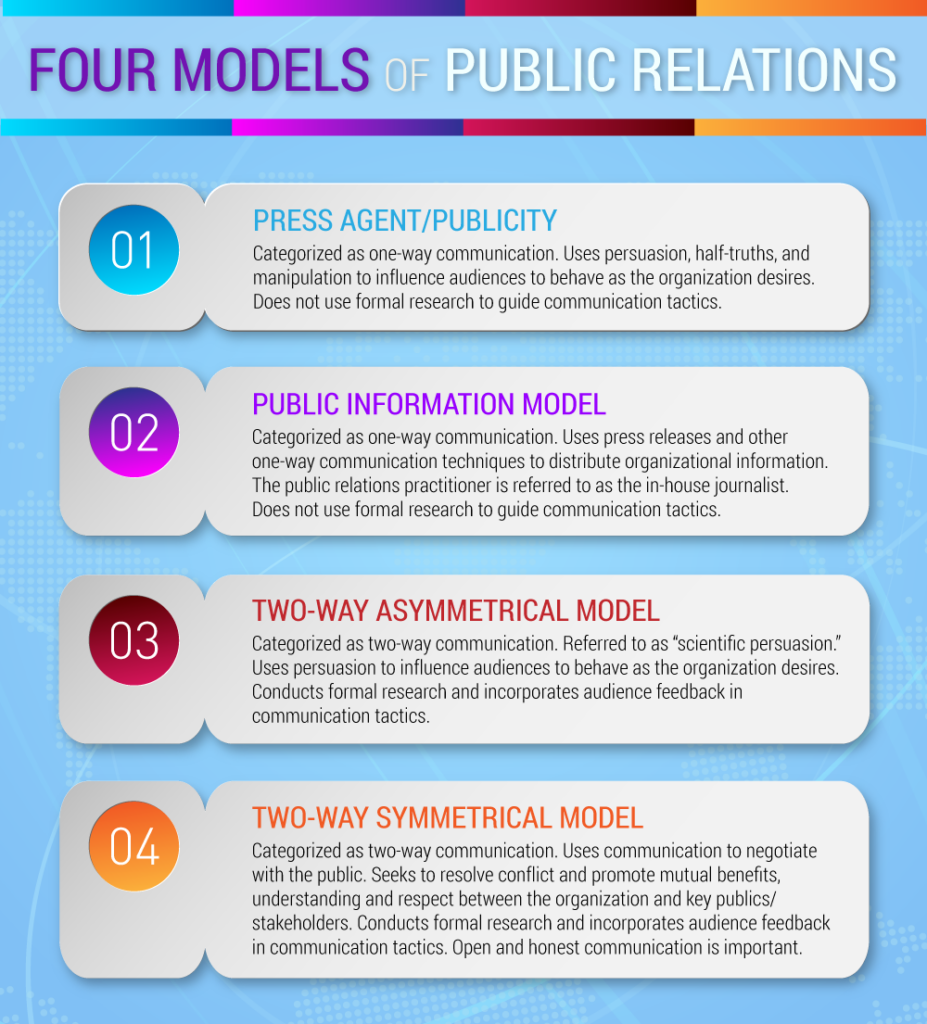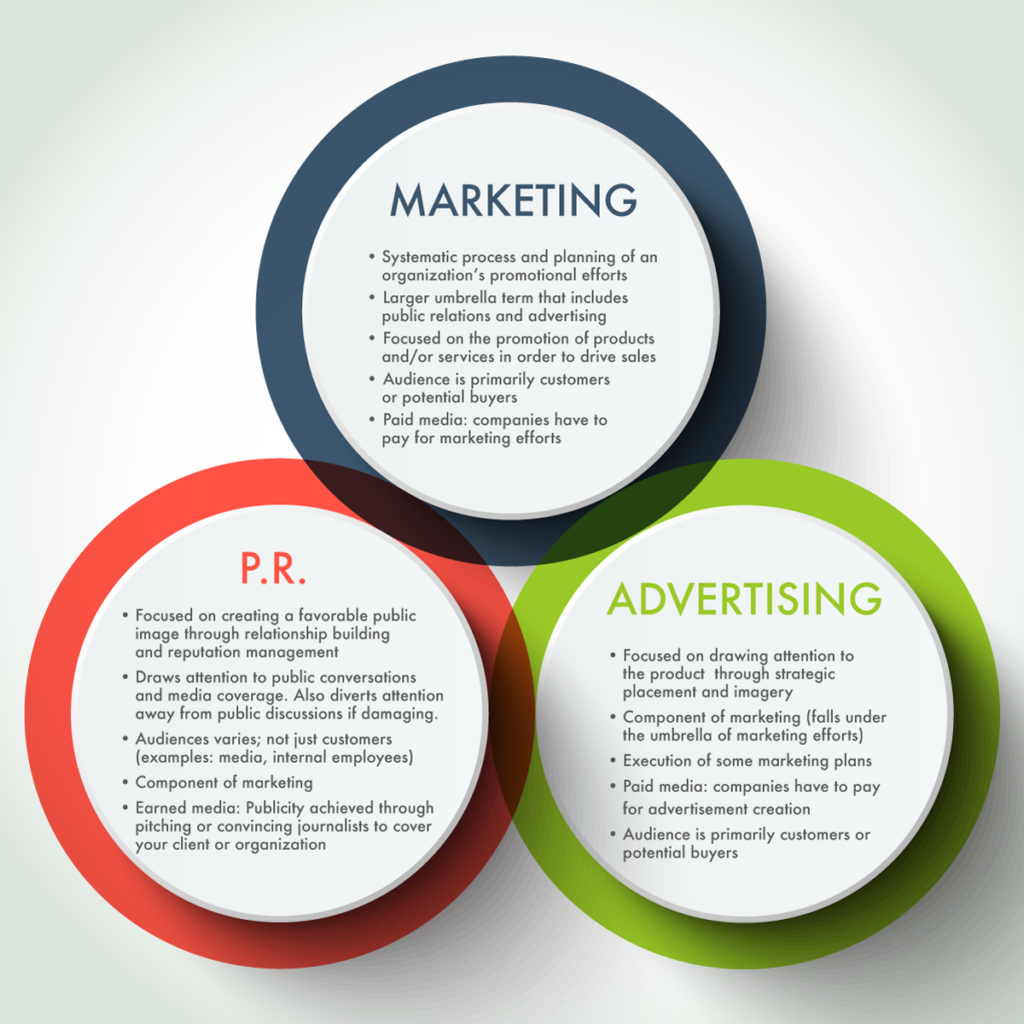38 What is public relations?
The Public Relations Society of America (PRSA) defines public relations as “a strategic communication process that builds mutually beneficial relationships between organizations and their publics” (2016, para. 4). Simply put, public relations helps to influence an audience’s perceptions by building relationships and shaping public conversations about a client or company. These public conversations often take place through mass media and social media, which is why public relations professionals need to understand how to work with and write effective messages for the media. Click here for more information on what you can expect in a public relations career.
Public relations professionals are in charge of a wide range of communication activities that may include increasing brand visibility and awareness, planning events, and creating content. Some of them also deal with crisis communication and help to salvage a brand’s integrity and reputation during a negative event. This video from Kate Finley, chief executive officer of Belle Communications, explains what it is like to work at a public relations agency.
39 Four models of public relations
Grunig and Hunt (1984) developed four models of public relations that describe the field’s various management and organizational practices. These models serve as guidelines to create programs, strategies, and tactics.

In the press agent/publicity model, communications professionals use persuasion to shape the thoughts and opinions of key audiences. In this model, accuracy is not important and organizations do not seek audience feedback or conduct audience analysis research. It is a one-way form of communication. One example is propagandist techniques created by news media outlets in North Korea.
The public information model moves away from the manipulative tactics used in the press agent model and presents more accurate information. However, the communication pattern is still one-way. Practitioners do not conduct audience analysis research to guide their strategies and tactics. Some press releases and newsletters are created based on this model, when audiences are not necessarily targeted or researched beforehand.
The two-way asymmetrical model presents a more “scientifically persuasive” way of communicating with key audiences. Here, content creators conduct research to better understand the audience’s attitudes and behaviors, which in turn informs the message strategy and creation. Still, persuasive communication is used in this model to benefit the organization more so than audiences; therefore, it is considered asymmetrical or imbalanced. The model is particularly popular in advertising and consumer marketing, fields that are specifically interested in increasing an organization’s profits.
Finally, the two-way symmetrical model argues that the public relations practitioner should serve as a liaison between the organization and key publics, rather than as a persuader. Here, practitioners are negotiators and use communication to ensure that all involved parties benefit, not just the organization that employs them. The term “symmetrical” is used because the model attempts to create a mutually beneficial situation. The two-way symmetrical model is deemed the most ethical model, one that professionals should aspire to use in their everyday tactics and strategies (Simpson, 2014).
Some experts think of public relations more broadly. For instance, they may argue that political lobbying is a form of public relations because lobbyists engage in communication activities and client advocacy in order to shape the attitudes of Congress (Berg, 2009). However, this book focuses on a public relations approach based particularly on writing for the media. Furthermore, the goal is to disseminate communication based on the two-way symmetrical model presented by Grunig and Hunt (1984).
Discussion Point
Do you think the two-way symmetrical model is plausible? Consider this example from Dr. William Sledzik, associate professor of journalism and mass communication at Kent State University:
“Can we realistically serve multiple stakeholders whose needs conflict? For example, can we represent the interests of loyal employee groups while our shareholders demand layoffs in favor of low-cost offshore suppliers?”
40 Why do companies need public relations?
There was a time when many companies did not see the value of public relations, unless a crisis happened. Even now, some public relations professionals face challenges in convincing key executives of their value to the function of the company.
With the abundance of information readily available to audiences worldwide, companies are more vulnerable than ever to misinformation about their brand. An audience’s attitudes and beliefs about a company can greatly influence its success. Therefore, the public relations professional helps to monitor and control conversations about a company or client and manage its reputation in the marketplace. Viewing public relations as a key management function of a business or an essential strategy to manage one’s individual reputation will help accomplish important goals such as establishing trust among key publics, increasing news media and social media presence, and maintaining a consistent voice across communication platforms.
For more on the impact of reputation on business success, take a look at this article from The Entrepreneur.
41 Public relations versus marketing versus advertising
Many people confuse public relations with marketing and advertising. Although there are similarities, there also are key differences.
Probably the most important difference between marketing, public relations, and advertising is the primary focus. Public relations emphasizes cultivating relationships between an organization or individual and key publics for the purpose of managing the client’s image. Marketing emphasizes the promotion of products and services for revenue purposes. Advertising is a communication tool used by marketers in order to get customers to act. The image below outlines other differences.

For more information on the differences between marketing, public relations, and advertising, read the following articles:
- Marketing versus PR: Five ways to tell the difference
- The real difference between public relations and advertising
42 General roles in public relations
According to Smith (2013), public relations practitioners can be placed in two groups based on responsibilities: communication managers and communication technicians. Communication managers assist in the strategic planning of an organization’s communication efforts. The broad term “communication manager” includes several similar public relations positions: expert consultant, problem-solving facilitator, and communication liaison. Expert consultants develop a specific communication plan to help achieve organizational goals. Problem-solving facilitators provide crisis management to an organization during an obstacle. Liaisons speak on behalf of the brand and facilitate communication between the organization and its key publics.
Before entering a managerial role, most public relation practitioners begin their career as a communication technician. This can refer to a variety of entry-level positions, including public relations specialist, communication assistant, and junior account executive. Communication technicians write press releases, pitches, feature articles, and other communication materials and assist in event planning. Together, communication managers and technicians play a vital role in relationship building and the management of a brand.
This article from PRSA provides tips to those beginning a career in public relations.
43 References
Berg, K. (2009). Finding connections between public relations, lobbying, and advocacy. Public Relations Journal, 3(3), 2-19.
Grunig, J. & Hunt, T. (1984). Managing public relations. New York: Holt, Rinehart and Winston.
Public Relations Society of America. (2016). About public relations. Retrieved from: https://www.prsa.org/aboutprsa/publicrelationsdefined/#.V7S9x4HF_Hc
Simpson, E. (2014). The four models in Grunig’s and Hunt’s PR theories. Linkedin.com. Retrieved from: https://www.linkedin.com/pulse/20140611205435-83891954-the-four-models-in-grunig-s-and-hunt-s-pr-theories
Smith, R. (2013). Strategic planning for public relations. New York, NY: Routledge.


